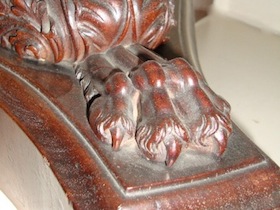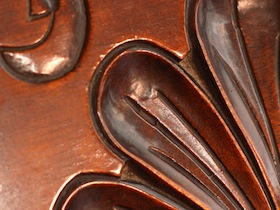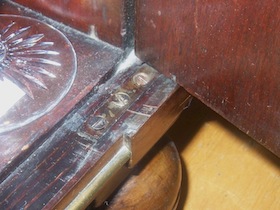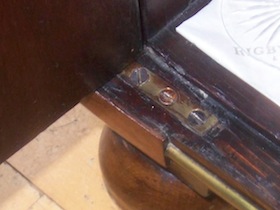


Last week we were asked to clean a number of lovely Georgian antiques at a beautiful home in the Oxfordshire countryside. Well looked after, the pieces were in fine condition; however years of simple domestic dusting had allowed dirt to build up in the corners, carvings, and grooves of the pieces, and this had started to concern our client.
 This build up of dust over time is known in the conservation industry as DUST CEMENTATION (seen here as light grey - top, and dark grey/black - bottom). Although it is extremely common, it is an issue that any conscientious antique owner or collector needs to be aware of because not only can it detract from an object's beauty, it can also lead to physical damage over time.
This build up of dust over time is known in the conservation industry as DUST CEMENTATION (seen here as light grey - top, and dark grey/black - bottom). Although it is extremely common, it is an issue that any conscientious antique owner or collector needs to be aware of because not only can it detract from an object's beauty, it can also lead to physical damage over time.

Dust cementation causes physical problems in two main ways. Firstly it attracts moisture - which can lead to damage occurring to the original varnish (and eventually to the wood underneath) - and secondly it provides a perfect breeding environment for pests, such as woodworm; making the likelihood of an infestation much more likely.
With the right equipment and knowledge, removing dust cementation is relatively straightforward, but it is also quite time consuming. The dust is compacted and hard and needs to be gently removed layer-by-layer. Conservation cleaners will either simply use a small hog's-hair brush to gradually brush each layer away, or they will sometimes use Renaissance Museum Wax which helps quicken the removal process. (Conservation cleaners will often use Renaissance Museum Wax in museums, however we do not recommend that it be used by anyone who is not trained in Conservation Housekeeping as it can cause damage if not applied properly.)
Once we had cleaned each of our client's antiques inside and out, we advised them not to use any cleaning products on the objects in future, and instead provided a museum approved microfiber cloth for them to be dusted with. We also provided a small hog's-hair brush for cleaning those areas where dust cementation had previously occurred, which should prevent further problems.


Before cleaning; After cleaning